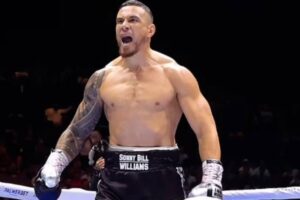Sydney celebrates the 90th anniversary of the discovery of the Harbor Bridge, which has since hosted millions of cars, countless climbs, fireworks and a historically defining reconciliation walk.
NSW Prime Minister Jack Lang was to open the bridge by cutting a ceremonial ribbon with scissors in front of a boisterous gathering of 300,000 Sydney residents at the height of the Great Depression on 19 March 1932.
Francis de Groot, however, had other ideas.
The former cavalry officer and member of the right-wing New Guard militia, ran past Lang on a racehorse as the clock struck 10, jumped forward and cut the band with a sword in a cinematic beat.
Historian Ian Hoskins, who wrote an award-winning book about Sydney Harbor, told the AAP that the bridge soon became a focal point for Australia’s place in the world as a modern nation.
“The Sydney Harbor Bridge not only became a symbol of Sydney, it became something that people very quickly recognized as Australian,” he said.
“It symbolizes a new modern Australia. It said, ‘Look what we can do, we’ve built this amazing bridge in just eight years.’
The architectural feature involves 40,000 tons of fabricated steel over 500 meters minus a medium support pillar.
Dr Hoskins said the massive Bridge Walk for Reconciliation in 2000, in which 250,000 people rallied for a new social contract with Native Australians, was not only “visually appealing” but a potent political moment.
“A bridge literally symbolizes a gap and connects two sides, two sides of an argument, two sides of an issue. So the bridge is a symbol of reconciliation in many respects,” he said.
Farmer and war veteran Ian Litchfield, 95, said he could take out a bottle of Glenfiddich Scotch while watching Hampton’s anniversary celebrations in central western NSW on Saturday.
The tip is to honor his father, one of the leading engineers who worked on the bridge.
“He was (bridge proponent John Bradfield) chief surveillance engineer for the manufacture and erection of the steelworks,” Mr Litchfield told AAP.
“We grew up with the bridge, it was discussed earlier at the dinner table when we were young.
“I’m very proud of my dad.”
Mr Litchfield does not recall the powerful structure with his father as a five-year-old, but the photos of the occasion are valuable to him.
What he remembers vividly burst with pride as he later arrived in Sydney and crossed the harbor by bus to attend meetings with fellow citizens who had served at HMAS Bataan in the Philippines during World War II.
“I always enjoyed it passing. I tried to get in the back of the bus so that you were higher, so that you could see the harbor,” he said.
Their last meeting was about four years ago. Mr Litchfield is the only one still walking.
Australian Associated Press

Add Comment